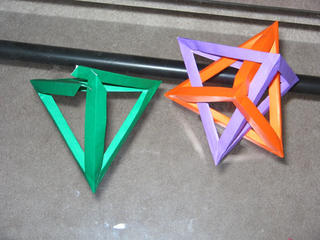Tom Hull's five interesecting tetrahedra, part one.
Well, I've got three of the five frames interwoven, so the easy part is over.
Here you can see two of the frames already together, with the third ready. I left a point open so I could place it around the other two. For frame construction, Tom Hull's instructions are pretty straightforward; I would recommend after putting two frame pieces together, using a toothpick to add a little glue along the seam.

Now, basically there are no set instructions for weaving them together after the first two. Tom Hull's site gives this advice:
There is a very strong symmetry behind the formation of this structure, and understanding this symmetry can aid you in the construction. The finished object should have the following property: any two tetrahedra are interwoven with one corner poking through a hole of the other and vice versa, kind of like a 3-D Star of David but slightly twisted. (This is what we tried to describe above.)
So, for the third frame, if I have a corner of the third frame going through the intersection of the first two frames (shown in green below) and have the the corners of the first two frames (circled in red) going through the same hole of the third frame, I should be OK.

And it looks like it will be.

And there it is; 60% done.

I'm hoping that I can get away with the same trick for the fourth and fifth frames, but I'm not sure if I'll be that lucky. I still have to fold the last two frames, but that's not the time-consuming part. Anyway, we'll see what happens...
Here you can see two of the frames already together, with the third ready. I left a point open so I could place it around the other two. For frame construction, Tom Hull's instructions are pretty straightforward; I would recommend after putting two frame pieces together, using a toothpick to add a little glue along the seam.

Now, basically there are no set instructions for weaving them together after the first two. Tom Hull's site gives this advice:
There is a very strong symmetry behind the formation of this structure, and understanding this symmetry can aid you in the construction. The finished object should have the following property: any two tetrahedra are interwoven with one corner poking through a hole of the other and vice versa, kind of like a 3-D Star of David but slightly twisted. (This is what we tried to describe above.)
So, for the third frame, if I have a corner of the third frame going through the intersection of the first two frames (shown in green below) and have the the corners of the first two frames (circled in red) going through the same hole of the third frame, I should be OK.

And it looks like it will be.

And there it is; 60% done.

I'm hoping that I can get away with the same trick for the fourth and fifth frames, but I'm not sure if I'll be that lucky. I still have to fold the last two frames, but that's not the time-consuming part. Anyway, we'll see what happens...

<< Home